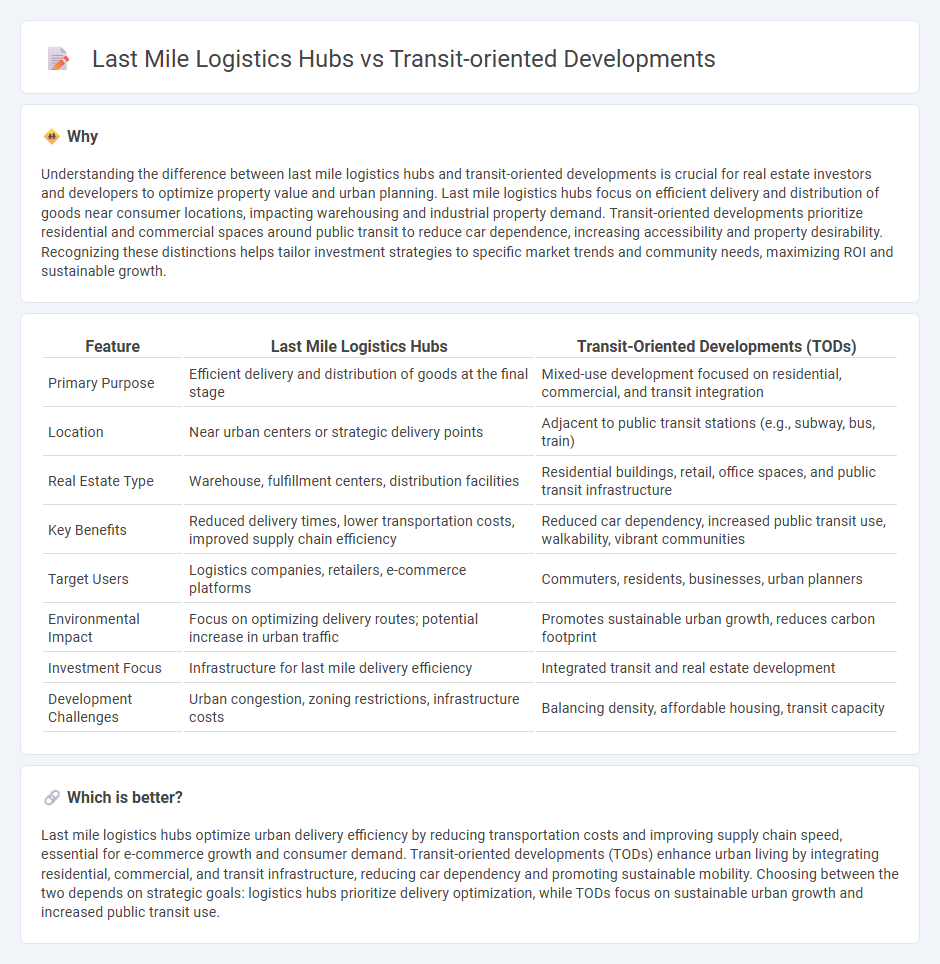
Last mile logistics hubs optimize urban supply chains by strategically locating near demand centers for faster delivery times, while transit-oriented developments focus on creating walkable communities around public transit stations to reduce reliance on cars. Both real estate models enhance urban efficiency but address different priorities: logistics hubs improve goods movement logistics, whereas transit-oriented developments prioritize sustainable, mixed-use living environments. Discover how these contrasting approaches shape the future of urban real estate and infrastructure.
Why it is important
Understanding the difference between last mile logistics hubs and transit-oriented developments is crucial for real estate investors and developers to optimize property value and urban planning. Last mile logistics hubs focus on efficient delivery and distribution of goods near consumer locations, impacting warehousing and industrial property demand. Transit-oriented developments prioritize residential and commercial spaces around public transit to reduce car dependence, increasing accessibility and property desirability. Recognizing these distinctions helps tailor investment strategies to specific market trends and community needs, maximizing ROI and sustainable growth.
Comparison Table
| Feature | Last Mile Logistics Hubs | Transit-Oriented Developments (TODs) |
|---|---|---|
| Primary Purpose | Efficient delivery and distribution of goods at the final stage | Mixed-use development focused on residential, commercial, and transit integration |
| Location | Near urban centers or strategic delivery points | Adjacent to public transit stations (e.g., subway, bus, train) |
| Real Estate Type | Warehouse, fulfillment centers, distribution facilities | Residential buildings, retail, office spaces, and public transit infrastructure |
| Key Benefits | Reduced delivery times, lower transportation costs, improved supply chain efficiency | Reduced car dependency, increased public transit use, walkability, vibrant communities |
| Target Users | Logistics companies, retailers, e-commerce platforms | Commuters, residents, businesses, urban planners |
| Environmental Impact | Focus on optimizing delivery routes; potential increase in urban traffic | Promotes sustainable urban growth, reduces carbon footprint |
| Investment Focus | Infrastructure for last mile delivery efficiency | Integrated transit and real estate development |
| Development Challenges | Urban congestion, zoning restrictions, infrastructure costs | Balancing density, affordable housing, transit capacity |
Which is better?
Last mile logistics hubs optimize urban delivery efficiency by reducing transportation costs and improving supply chain speed, essential for e-commerce growth and consumer demand. Transit-oriented developments (TODs) enhance urban living by integrating residential, commercial, and transit infrastructure, reducing car dependency and promoting sustainable mobility. Choosing between the two depends on strategic goals: logistics hubs prioritize delivery optimization, while TODs focus on sustainable urban growth and increased public transit use.
Connection
Real estate values near last mile logistics hubs often increase due to improved accessibility and faster delivery services, driving demand for transit-oriented developments (TODs) that integrate residential, commercial, and transit infrastructure. Transit-oriented developments reduce reliance on personal vehicles, enhance urban density, and support sustainable growth by aligning with last mile distribution networks. This synergy optimizes urban logistics efficiency while promoting mixed-use real estate projects and enhancing community connectivity.
Key Terms
**Transit-Oriented Developments:**
Transit-oriented developments (TODs) concentrate on creating high-density, mixed-use communities centered around public transit stations to reduce car dependency and promote sustainable urban growth. These projects integrate residential, commercial, and recreational spaces within walking distance of transit hubs, enhancing accessibility and encouraging environmentally friendly transportation options. Discover how TODs are reshaping urban landscapes and advancing sustainable mobility solutions.
Mixed-use zoning
Transit-oriented developments (TODs) prioritize mixed-use zoning by integrating residential, commercial, and recreational spaces around transit stations to reduce car dependency and enhance urban livability. Last mile logistics hubs focus on strategically positioned mixed-use zones combining warehousing, distribution centers, and commercial spaces to optimize delivery efficiency within dense urban areas. Explore more about how mixed-use zoning balances urban growth and logistics efficiency in smart city planning.
Walkability
Transit-oriented developments (TODs) prioritize walkability by integrating residential, commercial, and recreational spaces within close proximity to public transit stations, significantly reducing reliance on private vehicles. Last mile logistics hubs focus on efficient goods movement but often lack pedestrian-friendly infrastructure, hindering walkability and seamless urban mobility. Explore the dynamics between TODs and last mile logistics hubs to understand their impact on walkable city environments.
Source and External Links
Transforming the Urban Space Through Transit-Oriented Development - This publication discusses how transit-oriented development can transform urban spaces by concentrating jobs, housing, and services around public transport stations.
Transit-Oriented Development - This Wikipedia article provides an overview of transit-oriented development, highlighting its benefits and implementation around the world.
Transit-Oriented Development - This U.S. Federal Transit Administration (FTA) webpage explains how transit-oriented development supports economic growth, affordable housing, and community revitalization around transit systems.
 dowidth.com
dowidth.com